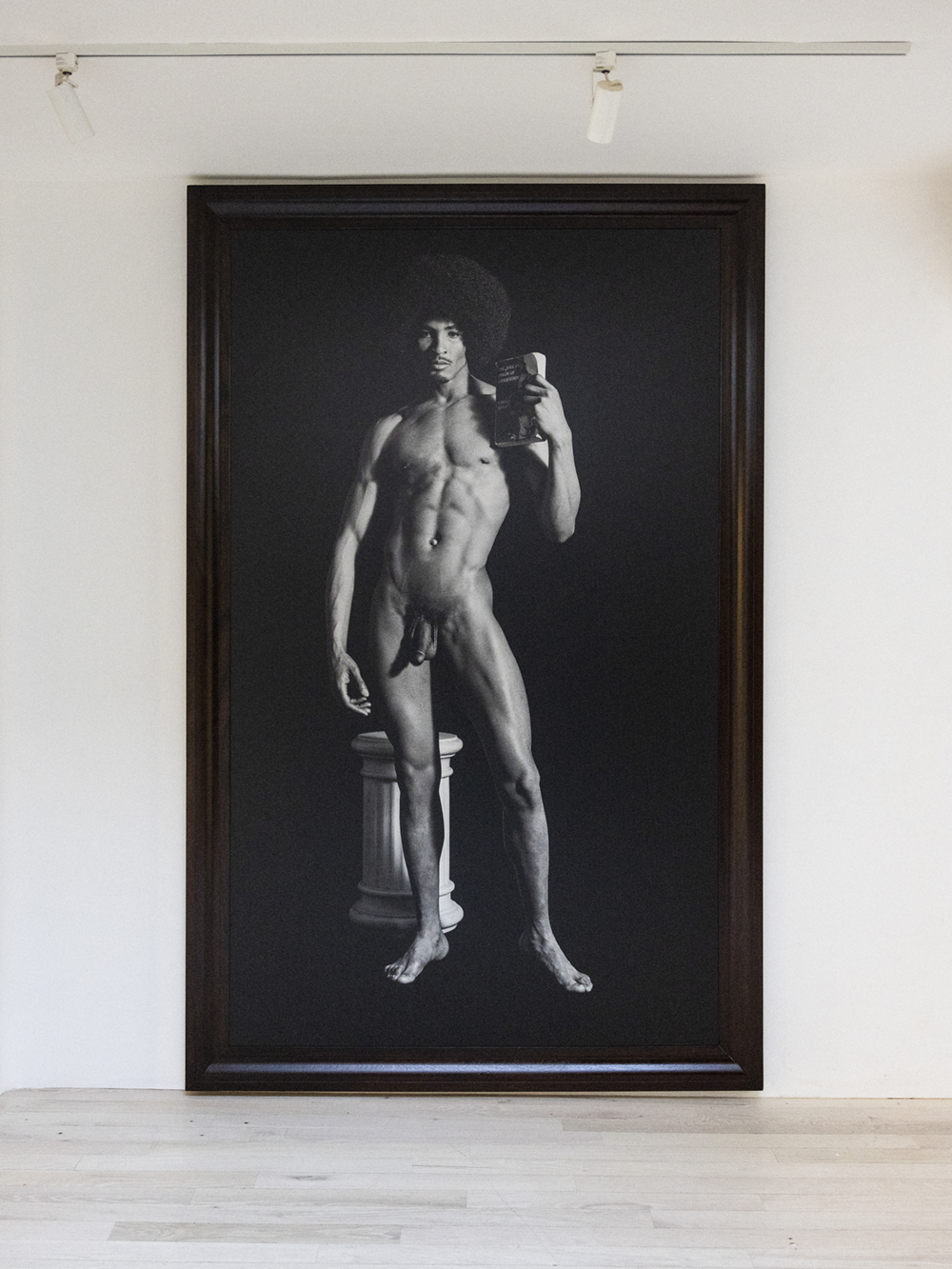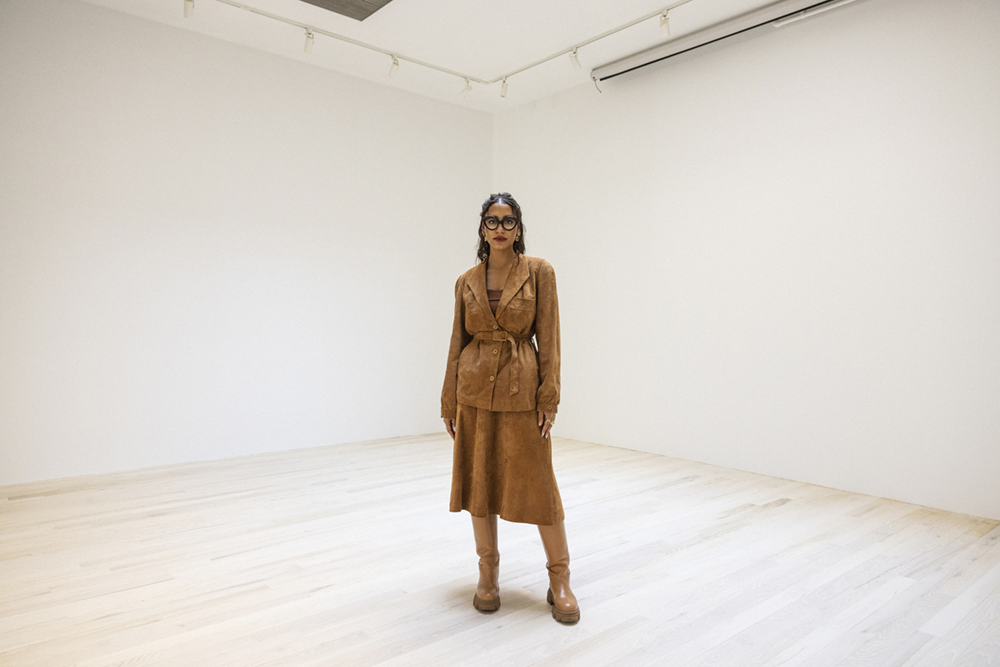On The Rise
Gallerist Hannah Traore
June 24, 2022
Writer Osman Can Yerebakan speaks with the young curator, who is among a new wave of gallerists reshaping representation and autonomy in the art world.
A few years ago, Hannah Traore found herself on a 13-hour car ride with her uncle traveling from Dakar to her dad’s hometown in Mali. She was going to see her grandmother for the first time in eight years. “She and I don’t share a mutual language, and this was my first time meeting her without my father translating,” she says. She had just been in West Africa on a travel grant from the Museum of Modern Art in New York, meeting with Dakar-based artists and curators—and it was time to bring the trip home for herself. “Being immersed in the art scene in Dakar was incredible, but reconnecting with her was quite special.” She remembers tears in both their eyes and an unspoken understanding between two intergenerational women.
Traore’s commitment to art and deep connections to her people have continued to shape her work today. After graduating from Skidmore College, an internship at MoMA led to a stint at the photography museum Fotografiska. From there, she went on to work for the influential curator Isolde Brielmaier, currently the deputy director of the New Museum. Earlier this year in January, the 27-year-old curator opened her namesake gallery on Manhattan’s Lower East Side. For her inaugural group exhibition, Hues, many of the artists were emerging talents she had crossed paths with in the past.
Traore is part of a young generation of gallerists responding to a gap in the industry—underrepresented artists of color and those who identify as queer or non-binary. Most of the people within Traore’s sphere are colleagues, artists she admires, and lifelong mentors who have advised her. Camila Falquez and James Perkins, who both currently have solo shows at the Hannah Traore Gallery, are also her close friends. “A couple of artists have told me that they’ve been waiting for someone who can actually understand them,” she says. “One of the reasons I wanted to open my gallery was to own this freedom to figure out my own progress.”
QLet’s start with the first experience that made you realize you want to work with artists.
AThe group exhibition, “Africa Pop Studio,” which I curated as my senior year thesis at Skidmore College, was a turning point. I had a desire to curate a show about the textile culture in Mali, but no student had organized an exhibition at the Tang Teaching Museum, which is a gorgeous building on the campus. I went to the museum director, Ian Berry, whom I had never met. He agreed when I shared my exhibition idea, but the concept eventually evolved into something focused on patterns with the Malian photographer Malick Sidibé’s images of life in Bamako at its center, along with other artists he inspired, such as Hassan Hajjaj, Derrick Adams, and Mickalene Thomas. That experience made me want to be a curator and connected me with incredible people.
QHow did you manage to put together a show with star artists as a college student?
ASome of the works came from the museum collection. For others, we secured loans from galleries and institutions, like six Sidibé works from Jack Shainman Gallery. We had a loan of a Kehinde Wiley painting from a private collection. Ian even ended up acquiring works for the museum collection to include in the show. Hassan, who years later curated one of my first exhibitions at my gallery, created an installation for the show.

QAfter graduating, you worked at the MoMA in New York. That must have been a great next step.
ADefinitely. The experience was priceless and I got paid while being educated. Serendipitously, Black Arts Council, which was then called Friends of Education, was funding my position that year. My time was supported by this affiliate which gave me an opportunity to help organize their events in the museum, such as exhibition tours, talks, and screenings. The chance to meet some of the people I look up to was the most valuable part of my work there. Years later, today, I am a member of this MoMA affiliate, and we had our benefit gala at the museum last week.
QYou eventually also worked under the independent curator Isolde Brielmaier.
AI met Isolde at Tang where she was the curator-at-large. She took an interest in me after seeing the show and connected with her only contact in Toronto. He was a dentist but also an influential collector who hired me to curate a show. At the time, I was looking for a way to return to New York and Isolde offered me to work for her and help with her shows and catalogs. This was also the summer of 2020 with a big moment of reckoning and a feeling of empowerment to change things. I knew working under an independent curator like her would be priceless, and it truly was. I worked with her on projects, including an exhibition for the Smithsonian Museum with the architect Suchi Reddy. Suchi was actually the first person to acquire from my gallery, so she has invoice 0001.
QWhen did you realize you could take matters into your own hands and open your own gallery?
AI started thinking about what needs to be fresh in this scene and what would make people excited today. I’ve seen a lot of exploitation, ignorance, and underrepresentation—so many artists are tokenized, persons of color, artists who are queer, immigrant, Indigenous… Many are aware of this and feel an internal fight about accepting the opportunity to show their work and feel like a token or refuse to exhibit. Then when my sister asked why I don’t just open a gallery myself, I realized I have a strong vision for what I want. I also realized at that point I had enough connections in New York and outside. I had enough people in my circle to introduce me to the right people to create the gallery. My art lawyer, whom I met at Black Arts Council, introduced me to my business consultant who introduced me to my publicist who introduced me to Camila Farquez. My business consultant is married to my bookkeeper; they’re my uncles, and whenever I need advice, they have my back. I'm a huge believer that it takes a village, and it did for this gallery.

QYou’re part of a new generation of Black women dealers and gallerists. How do you see this current moment of representation in the art world?
AThe more curators who actually belong to these underrepresented groups have a chance to organize shows, the more artists from those groups can be in places where they feel fully seen within the gallery system. I am excited to be one of a few with Nicola Vassell, Cierra Britton, or Storm Ascher. There are a lot of women who are really making a difference. I currently don’t represent artists but work with them on an exhibition basis. Some of them like Hassan Hajjaj already work with other galleries and with others. I am experiencing organic growth and progress over time with collaborations on a few shows.
QHow do you connect with new artists? Do you use social media or do you believe in the importance of the physical interaction?
AJames [Perkins] and I first connected over Instagram. He started following me years ago after he approached me at the Independent art fair. I thought his work was incredible and I followed him back, and he was the first person I approached for a collaboration when I opened my gallery. In our first meeting, we talked for hours about the exploitation of Black artists or the figurative movement, and we realized we both have strong opinions about this and bonded immediately. That real connection is very important. When Linda Goode Bryant made the introduction speech to honor Lorraine O’Grady at The Kitchen gala, she talked about their lifelong sisterhood from back in the day when she showed her work before anyone else. That’s what I am trying to have with my artists.
“THE MORE CURATORS WHO ACTUALLY BELONG TO THESE UNDERREPRESENTED GROUPS HAVE A CHANCE TO ORGANIZE SHOWS, THE MORE ARTISTS FROM THOSE GROUPS CAN BE IN PLACES WHERE THEY FEEL FULLY SEEN WITHIN THE GALLERY SYSTEM.”
Osman Can Yerebakan is a New York-based freelance art and culture writer, and curator.
